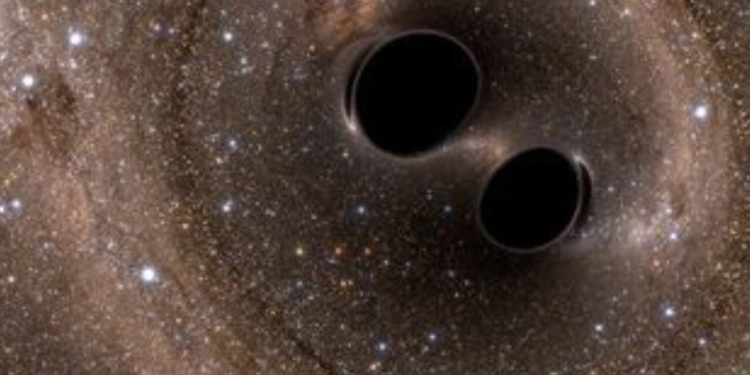Imagine a cosmic metropolis where supermassive black holes reign supreme. These behemoths, millions or even billions of times the Sun’s mass, reside at the heart of galaxies, exerting their immense gravitational pull on everything around them. A new study sheds light on a fascinating phenomenon in these galactic centers: colossal traffic jams that can lead to inevitable collisions between smaller black holes.
Galactic Titans and Stellar Hitchhikers
Our story begins with supermassive black holes, surrounded by swirling disks of gas and dust called accretion disks. These disks act as a cosmic feeding ground for the black holes, and their gravity creates powerful tidal forces that make the disks glow brightly, forming an Active Galactic Nucleus (AGN). Within these swirling disks reside smaller black holes – stellar-mass black holes, the collapsed remnants of massive stars.
The Peril of Stellar Black Holes
The swirling gas in the accretion disk can have an unexpected effect on these stellar-mass black holes. Their interaction with the gas causes them to migrate through the disk, like cosmic hitchhikers. The study suggests that these migrations can lead the black holes to accumulate in specific regions, coined “migration traps.”
Cosmic Rush Hour: A Collision Course
These migration traps become the epicenters of galactic gridlock. With a high concentration of stellar-mass black holes trapped within a confined space, the chances of collisions increase dramatically. Imagine a busy intersection without traffic lights – that’s the essence of a migration trap. The trapped black holes, lacking the freedom to move freely, are more likely to slam into each other, merging to form even larger black holes.
Cosmic Pileups and Gravitational Waves
The immense gravitational influence of the supermassive black hole at the center plays a crucial role in this process. Its gravity acts as a catalyst, continuously funneling stellar-mass black holes into migration traps and fueling further collisions. This relentless process, over vast stretches of time, can lead to the formation of truly gargantuan black holes, shaping the overall black hole population within a galaxy.
A Boon for Gravitational Wave Astronomy
The study’s implications extend beyond our understanding of black hole mergers. When stellar-mass black holes collide, they unleash a burst of ripples in spacetime known as gravitational waves. By pinpointing the locations where these mergers are most likely to occur (migration traps around supermassive black holes), scientists can refine their search strategies for gravitational waves, a burgeoning field of astronomy. This targeted approach can lead to the detection of more gravitational wave events, allowing us to probe the universe’s deepest mysteries.
A Step Closer, But Mysteries Remain
This research represents a significant leap forward in our understanding of how black hole mergers occur within galaxies. It paints a picture of a dynamic galactic center, where colossal traffic jams and inevitable collisions shape the black hole population. However, the universe continues to hold its secrets close. Despite these advancements, much remains unknown about the complex physics governing black holes and their environments. Future research, building on this foundation, promises to unravel these mysteries, offering a deeper glimpse into the heart of galaxies and the dance of these enigmatic objects.
One particularly intriguing avenue for future exploration is the possible influence of additional factors on migration traps. The study focused on the role of thermal effects, but other forces, like magnetic fields within the accretion disk, could also play a part. A more comprehensive understanding of these factors will enable scientists to create even more detailed simulations of galactic centers, further refining our knowledge of black hole mergers and the evolution of galaxies.



















